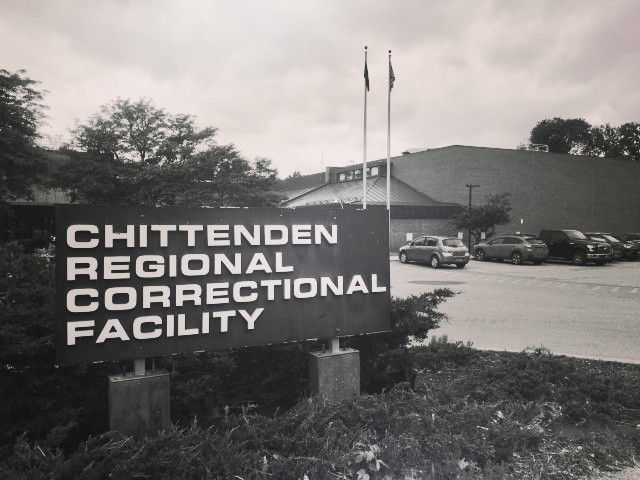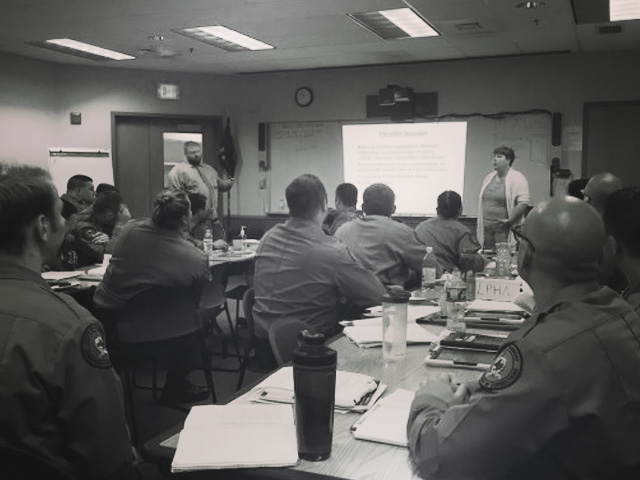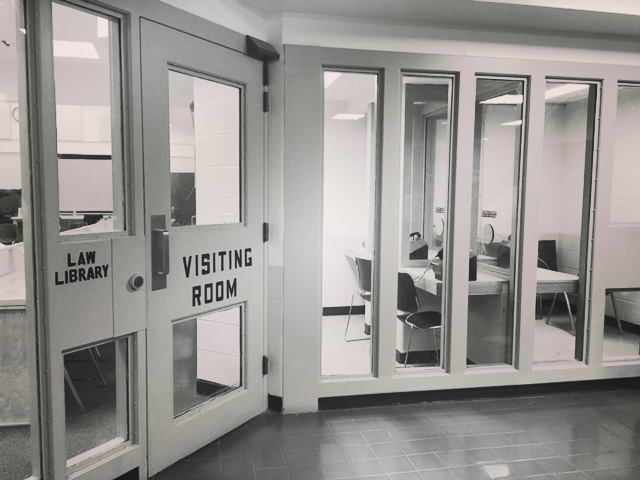The minute Ashley Sawyer walked into prison in February of 2015, everyone knew who she was. Her partner, Annette Douglas, had died in the same facility one month earlier.
“There was an instant judgment made before I even got to present who I was or how I identified,” Sawyer said in an interview. The prison was small, and Douglas had talked about her. It was known that Sawyer dated women, so she was watched, closely.
Sawyer, 34, says she became close friends with another inmate in Chittenden Regional Correctional Facility, Vermont’s only women’s prison. She maintains that the two never fooled around, never even kissed. But “people joked that Amanda was my prison wife,” Sawyer said.

Outside the facility Sawyer was held at. Photo by author.
One day, Sawyer and Amanda were in the showers in the housing unit they shared – showering at the same time, but in separate stalls, Sawyer told me. But that didn’t matter. Another inmate alerted an officer, who kicked the pair out of the shower, dripping wet.
“I was instantly angry,” Sawyer said. “I got dressed and opened my cell door and freaked out on the whole dayroom.” There was never any formal disciplinary action taken, Sawyer said, no reports or follow-ups. Just a moment of utter humiliation.
September 2018 marks the 15th anniversary of the Prison Rape Elimination Act (PREA), a law and accompanying standards that addressed rampant sexual abuse and misconduct in federal, state and local prisons across the country. PREA provided prisons with the guidelines for staff training and technical assistance to prevent sexual assaults and protect victims. It also called for the development of more specific standards, some of which would protect lesbian, gay, bisexual, transgender and intersex inmates. Those standards include mandatory staff training, screening LGBTQI inmates for likelihood of victimization, and bans on searches solely to determine genital status.
But PREA didn’t just change a few rules; it was a complete shift in the culture of American prisons. And to a great extent, it has succeeded in making prisons significantly safer for LGBTQ people. But PREA wasn’t an anti-discrimination bill, and for many queer folks, the already traumatic experience of incarceration is still heightened by bullying, abuse and a simple lack of understanding – from other inmates and from corrections staff.
Since she left Chittenden Regional Correctional Facility in 2016, Sawyer has become a criminal justice reform activist. “PREA came out of a lot of really horrific situations for people. We had queer people and transgender people being raped and being put into jails that they shouldn’t have been put into. We had women being sexually assaulted by male guards,” Sawyer said. But in her experience, a law that was intended to keep people safe had been turned into “another tool to dehumanize people.”
How We Got PREA
LGBTQ people make up a disproportionate percentage of the prison population. An astounding 33.3 percent of women in prisons and 26.4 percent of women in jails self-identify as lesbian or bisexual, rates that are three times higher than that of the general U.S. population. That’s also higher than rates for men identifying as gay or bisexual in prisons or jails (9.3 and 6.2 percent, respectively). And those people are at a significantly higher risk of sexual assault when they are in a correctional facility.
A February 2017 study in the American Journal of Public Health found that 12.2 percent of sexual minorities reported being sexually victimized by another inmate and 5.4 percent reported being victimized by staff, compared with 1.2 and 2.1 percent of straight inmates, respectively.
Transgender people are by far the most vulnerable, with an estimated 35% of transgender inmates in federal prisons and 34% in local jails reported experiencing one or more incidences of sexual violence at the hands of staff or a fellow inmate, according to Bureau of Justice Statistics data from 2015.
The U.S. government knew about the culture of rape and sexual abuse in prisons in the 1990s, but they failed to take the issue seriously. Lawmakers were particularly unmoved by reports of the victimization of female inmates. In fact, legal scholar Brenda V. Smith wrote in 2008 that PREA only got off the ground because of a concern among lawmakers and conservative groups that “innocent” white male prisoners would be victimized by more sophisticated inmates and would be exposed to HIV.
But after lobbying and rounds of revisions from groups across the political spectrum, Congress unanimously passed PREA in 2003. The Department of Justice spent nearly a decade studying the problem and began implementing regulations in May of 2012. Now, staff is trained to identify and prevent sexual assault, rape kits and counseling are provided to victims, and facilities have to pass audits or risk losing some federal funding.
“There’s the actual act itself, then there’s the federal PREA standards,” said Jen Sprafke, the assistant superintendent at Chittenden Regional Correctional Facility, where Sawyer was detained. Sprafke also served as the PREA Training Coordinator and PREA Director for the Vermont Department of Corrections, and trains corrections staff on working with LGBTQI inmates. “The PREA standards said you’ve got to come up with your way of doing it. These are some things you can’t do, so you better figure out what you can do.”

Jen Sprafke training officers on caring for women inmates. Photo by author.
States got to work passing their own legislation and changing facility procedures. Among the changes were limits on cross-gender viewings and searches (who could conduct strip searches on whom), mandatory reporting of sexual assault, and procedures for what would happen if an assault was reported.
“It forced the conversation,” Sprafke added. “It didn’t set the rules, but it made states pay attention to the issue and come up with what they were going to do.”
In Vermont, the conversation led to a four-hour session on caring for queer people during the five-week training program for corrections officers. The training covers LGBTQI terminology, as well as expectations for how staff will treat LGBTQI inmates.“What we say at the beginning of the training is, this is not about changing someone’s mind,” Sprafke said. “People are allowed to believe what they want to believe. But this is the department’s understanding, this is the department’s set of definitions, and once we conclude this training, these are the words that we expect that folks will use.”
How PREA Affects Transgender Inmates
Dylen Hathaway, 36, was the first openly transgender man detained in the Vermont Department of Corrections. He first entered incarceration at the state’s women’s prison in 2003, where he remained until 2005. “They had no idea what to do with me,” he said.
Hathaway said it was determined that his testosterone prescription was not “medically necessary.” In those early years, he said, certain corrections officers would use she/her pronouns just to upset him. They used his dead name on purpose. He already struggled with self-harm, but the trauma of being misgendered and denied hormones worsened that behavior.
The second time Hathaway encountered the VDOC was for a few short months in 2013, and then a longer sentence beginning in 2013 and ending in 2015. By that time, PREA had gone into effect and Vermont had made significant strides towards protecting vulnerable groups.
This time, Hathaway was asked to fill out a form as soon as he was brought to Chittenden Regional Correctional Facility. He provided his gender, sexuality, pronouns, preferred name and special accommodations he was requesting as a trans person. Hathaway said he requested men’s underwear and a separate shower time.
Both these requests came with consequences. Women’s underwear was provided to him for free, but he’d have to pay commissary for the same underwear that cis men inmates received automatically. And the separate shower meant every time he bathed, Hathaway was singled out. His pronouns were mostly respected this time, but when the logistics of his shower proved especially difficult, Hathaway said, certain officers would call him “princess.”
Like Ashley Sawyer, Hathaway found his sexuality policed. Hathaway had a consensual relationship with another trans inmate, and they did fool around, mostly in the shower. But on the other man’s last day in the prison, Hathaway recounted, the two men were showering in separate stalls. Like Sawyer, the two were thrown out of the shower. “We weren’t doing anything,” he said. “They just put him in the hole” – administrative segregation – “for hearsay.”
Sprafke, the assistant superintendent, said that separation following an allegation of what she called “sexualized behavior” is done on a case-by-case basis. “If somebody is moving, whether it’s out of a cell or out of a unit, the priority is always to move the alleged perpetrator.”
The challenge, though, according to Sprafke, is determining what consent looks like in a prison environment. “If two people engage in a sexual act and say that it was consensual, we don’t actually know that it was consensual, because there are power dynamics where we don’t know who’s strong-arming who. We don’t know if someone is getting something from someone. And so we have to assume, in all cases, that maybe the person isn’t saying it right now, but they’re going to say it later, that it’s non-consensual.”
A mental health worker in a Vermont correctional facility, who asked not to be named because they were not authorized to speak to the media, said that PREA has also been used to further target LGBTQ inmates. “There is no consensual sex under PREA,” this worker told me, “at least not in Vermont. In the most basic terms, inmates are considered property of the department, and they’re not entitled to make their own decisions about their sexual interactions.”
Sawyer said that when she left Chittenden in 2015, and even more recently according to women she speaks to in the facility currently, most guards don’t allow any touching, even platonic touch between inmates. “There’s no hand-holding, there’s no touching, there’s no hugging, there’s no nothing. … Do some officers allow it? Yeah. Do people do it anyway? Absolutely.”
Still, the mental health worker said that PREA standards and subsequent legislation had brought about significant positive changes. Sexual abuse reporting hotlines, a number that inmates can call to report abuse, has increased clarity about just how many sexual assaults occur in prisons. More people receive hormone treatment in the Department of Corrections, and have an easier time accessing things like gender-appropriate underwear. And many people in positions of authority in the DOC — particularly women and queer people — were actively advocating on behalf of queer inmates.
Moving Forward
Until 2015, case law in the U.S. Court of Appeals for the Second Circuit, which includes Vermont and a number of other states, stated that unwanted genital touching and verbal assault were morally reprehensible, but didn’t violate the Constitution.
“The courts look to evolving standards of decency to figure out what is cruel and unusual punishment,” said Gabriel Arkles, a senior attorney at the American Civil Liberties Union. And the Second Circuit judges took PREA into consideration when they overturned the previous ruling, Boddie v. Schneider. “One way that PREA has been helpful, is shifting norms in the courts, and hopefully beyond that, around what can just be shrugged off and what is actually serious sexual violence that people can seek some sort of redress for.”

Inside of Chittenden. Photo by author.
In essence, Arkles added, PREA would be excellent if it were thoroughly implemented and enforced. PREA regulations say that investigators aren’t supposed to assume the guards have any more credibility than prisoners, but that often doesn’t happen in practice. “Right now, it’s very often that when a guard assaults a prisoner, it’s just that prisoner’s word against the guard. If the prisoner’s word were taken seriously, and not as an attempt at manipulation or a lie, that could really shift things.”
The hard-fought gains in individual facilities, at the state level in the courts are under threat in the Trump administration. In May of this year, Attorney General Jeff Sessions ignored PREA when he advised the Bureau of Prisons to disregard a person’s gender identity and expression in determining placement and instead house trans inmates based on “biological sex.” Without clear guidance and moral leadership from the federal government, states have less incentive to protect their most vulnerable inmates.



“LGBTQ people make up a disproportionate percentage of the prison population. An astounding 33.3 percent of women in prisons and 26.4 percent of women in jails self-identify as lesbian or bisexual, rates that are three times higher than that of the general U.S. population. That’s also higher than rates for men identifying as gay or bisexual in prisons or jails (9.3 and 6.2 percent, respectively). And those people are at a significantly higher risk of sexual assault when they are in a correctional facility.”
Can we get a source on these stats, please?
Didn’t see they were all from the same study, disregard previous request!
Thank you for sharing this information!
In a related question, how are they checking for “biological sex”? Like what would this mean for intersex inmates or the inmate who is trans, but with also intersex?
Thanks so much for this article!